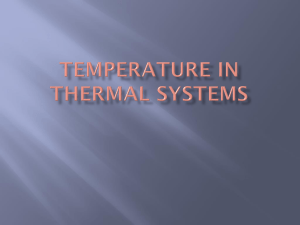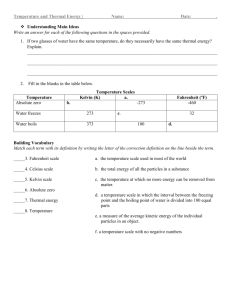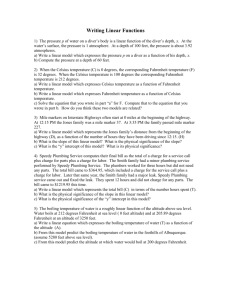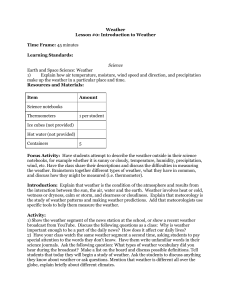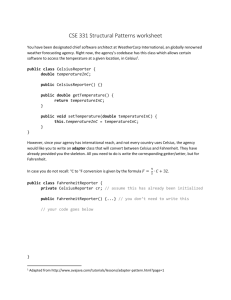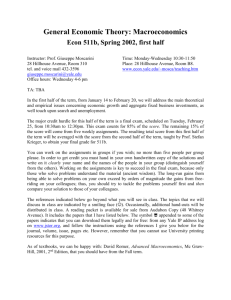AP Physics 2 Chapter 13-14-15 Review
advertisement
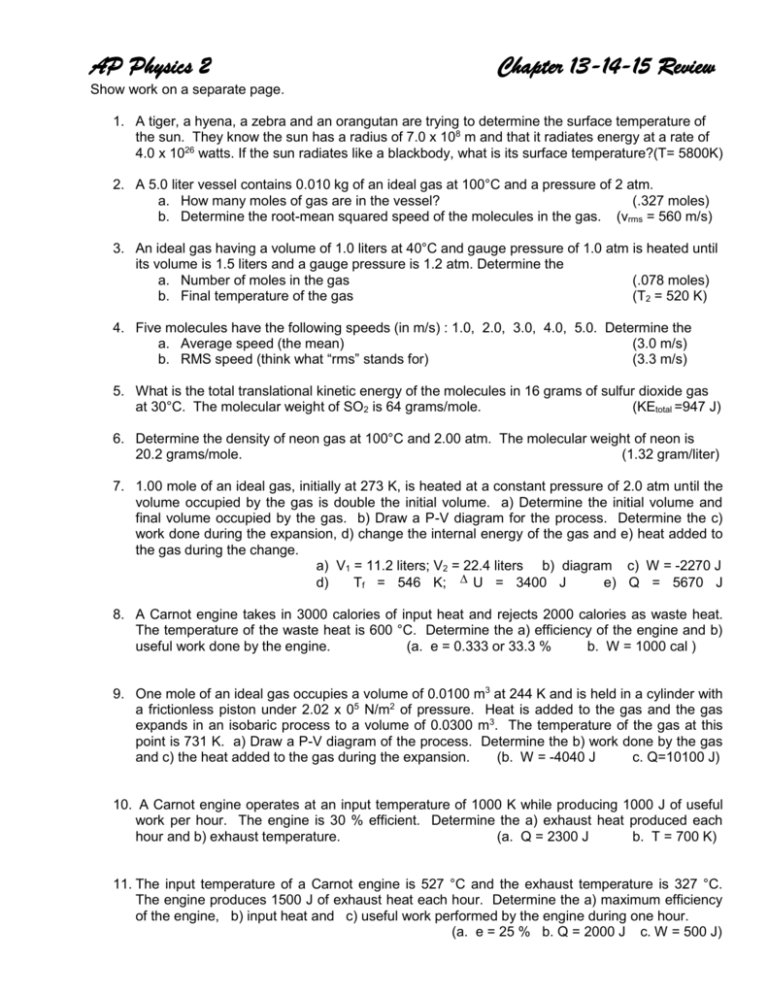
AP Physics 2 Chapter 13-14-15 Review Show work on a separate page. 1. A tiger, a hyena, a zebra and an orangutan are trying to determine the surface temperature of the sun. They know the sun has a radius of 7.0 x 108 m and that it radiates energy at a rate of 4.0 x 1026 watts. If the sun radiates like a blackbody, what is its surface temperature?(T= 5800K) 2. A 5.0 liter vessel contains 0.010 kg of an ideal gas at 100°C and a pressure of 2 atm. a. How many moles of gas are in the vessel? (.327 moles) b. Determine the root-mean squared speed of the molecules in the gas. (vrms = 560 m/s) 3. An ideal gas having a volume of 1.0 liters at 40°C and gauge pressure of 1.0 atm is heated until its volume is 1.5 liters and a gauge pressure is 1.2 atm. Determine the a. Number of moles in the gas (.078 moles) b. Final temperature of the gas (T2 = 520 K) 4. Five molecules have the following speeds (in m/s) : 1.0, 2.0, 3.0, 4.0, 5.0. Determine the a. Average speed (the mean) (3.0 m/s) b. RMS speed (think what “rms” stands for) (3.3 m/s) 5. What is the total translational kinetic energy of the molecules in 16 grams of sulfur dioxide gas at 30°C. The molecular weight of SO2 is 64 grams/mole. (KEtotal =947 J) 6. Determine the density of neon gas at 100°C and 2.00 atm. The molecular weight of neon is 20.2 grams/mole. (1.32 gram/liter) 7. 1.00 mole of an ideal gas, initially at 273 K, is heated at a constant pressure of 2.0 atm until the volume occupied by the gas is double the initial volume. a) Determine the initial volume and final volume occupied by the gas. b) Draw a P-V diagram for the process. Determine the c) work done during the expansion, d) change the internal energy of the gas and e) heat added to the gas during the change. a) V1 = 11.2 liters; V2 = 22.4 liters b) diagram c) W = -2270 J d) Tf = 546 K; U = 3400 J e) Q = 5670 J 8. A Carnot engine takes in 3000 calories of input heat and rejects 2000 calories as waste heat. The temperature of the waste heat is 600 °C. Determine the a) efficiency of the engine and b) useful work done by the engine. (a. e = 0.333 or 33.3 % b. W = 1000 cal ) 9. One mole of an ideal gas occupies a volume of 0.0100 m3 at 244 K and is held in a cylinder with a frictionless piston under 2.02 x 05 N/m2 of pressure. Heat is added to the gas and the gas expands in an isobaric process to a volume of 0.0300 m3. The temperature of the gas at this point is 731 K. a) Draw a P-V diagram of the process. Determine the b) work done by the gas and c) the heat added to the gas during the expansion. (b. W = -4040 J c. Q=10100 J) 10. A Carnot engine operates at an input temperature of 1000 K while producing 1000 J of useful work per hour. The engine is 30 % efficient. Determine the a) exhaust heat produced each hour and b) exhaust temperature. (a. Q = 2300 J b. T = 700 K) 11. The input temperature of a Carnot engine is 527 °C and the exhaust temperature is 327 °C. The engine produces 1500 J of exhaust heat each hour. Determine the a) maximum efficiency of the engine, b) input heat and c) useful work performed by the engine during one hour. (a. e = 25 % b. Q = 2000 J c. W = 500 J) On the Fahrenheit scale, why is 32 freezing and 212 boiling? What do 0 and 100 mean? Researchers have gone to their graves trying to figure out what old man Fahrenheit was up to. as well as I can piece it together: Here’s the story Daniel Gabriel Fahrenheit (1686-1736) was a German instrument maker who invented the first practical mercury thermometer. Casting about for a suitable scale for his device, he visited the Danish astronomer Ole Romer, who had devised a system of his own. As it turned out, it was a case of the blind leading the blind. Romer had decided that the boiling point of water should be 60 degrees. This at least had the strength of numerological tradition behind it (60 minutes in an hour, right?). But zero was totally arbitrary, the main consideration apparently being that it should be colder than it ever got in Denmark. (Romer didn’t like using negative numbers in his weather logbook.) In addition to the boiling point of water, the landmarks on Romer’s scale were the freezing point of water, 7-1/2 degrees, and body temperature, 22-1/2 degrees. D.G. , simple soul that he was, thought his cockeyed system was the soul of elegance. He made one useful change: to get rid of the fractions, he multiplied Romer’s degrees by 4, giving him 30 for freezing point and 90 for body temperature. Then, for reasons nobody has ever been able to fathom, he multiplied all the numbers by 16/15, making 32 freezing and 96 body temperature. Boiling point for the time being he ignored altogether. By and by Fahrenheit got ready to present his scale to London’s Royal Society, the scientific big leagues of the day. It dawned on him that it was going to look quite a little strange having a zero on his scale just sort of hanging off the end, so to speak. So he cooked up the explanation that zero was the temperature of a mix of ice, water, and ammonium chloride. At some point Fahrenheit figured out that the boiling point of water came in at 212 degrees. Over time this replaced body temp as the upper land mark on his scale. Meanwhile, as more precise measurements were made, body temperature had to be adjusted to 98.6 degrees. In short, 100 means nothing at all on the Fahrenheit scale, 96 used to mean something but doesn’t anymore, and 0 is colder than it ever gets in Denmark. Brilliant. Lest we get too down on Fahrenheit, though, consider Ander Celsius, who devised the centigrade scale (0 to 100) Everybody agrees Celsius’s scale makes more sense than Fahrenheit’s. Trouble is, the original Celsius scale had 100 for freezing, 0 for boiling. In other words, it was upside-down. (The numbers were reversed after Celsius’s death.) These thermometer guys, what gets into them? Must be too much mercury exposure.


